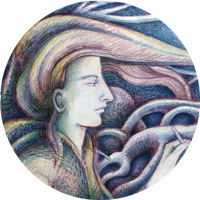
After noticing the lime tree in Withdean Woods (see last blog post), I remembered that the tree planted in remembrance of my mother, is a large-leaved lime, Tilia platyphyllos. I took a mini pilgrimage across town to the woodland cemetery to spend some time with my mum’s tree.
There are three lime trees native to the UK, small-leaved, large-leaved and common. Large-leaved limes like to grow on lime rich soils.
Lime trees are also called linden trees in Europe. They are pollinated by insects, so will not produce as much pollen as wind pollinated trees like oaks or beech. After the last Ice Age small-leaved limes dominated the lowland forests of the UK, especially in the south and east.
The lime tree was considered a sacred tree in Eastern Europe. The Polish word for the month of July, Lipiec, is named after the word for lime, lipa, and the names of many villages translate as Holy Lime.

Within the dark branches of this beautiful tree dwelt goddesses and gods. In countries such as Lithuania, Laima, a goddess of fate, fertility, childbirth and death held the linden as her sacred tree. She was worshipped by women, who prayed and carried out rituals within the tree’s leafy shade. When a child was born they made offerings there to the goddess. Laima is often associated with the cuckoo, Gegute, who watched over time and the seasons.
In German folklore the lime tree was an important tree of Freyja, the goddess of truth and love. It was thought of as a lover’s tree, perhaps because of its heart shaped leaves. In pre-Christian times it was believed that it was impossible to tell lies while standing beneath a linden tree. For this reason communities held judicial councils, along with celebrations such as weddings and festivities, beneath the tree that was often found in the centre of the town or village.
![]()
Sitting for a while in the grass in the shade of my mother’s tree, I listened to the birds, wrote some notes in my diary and pressed a few leaves between the pages.


Then I replenished the seed in the bird feeder and hung up a simple string of feathers, shells and beads. The feathers once belonged to a green woodpecker, the “Rain Bird“, so named because it was thought to foretell the coming of rain. I think the trees need rain, but I’m quite happy with sunshine at the moment.
Goddesses, cuckoos, lime trees and rain birds – I’ve drawn an illuminated letter for the lime tree, beneath a sun and a crescent moon. Click on the image to see a larger version:

I have decided to research and write a small book about tree and forest goddesses to accompany my book, Goddesses of River, Sea and Moon. Below is a picture of Laima.

“Trees are sanctuaries. Whoever knows how to speak to them, whoever knows how to listen to them, can learn the truth. They do not preach learning and precepts, they preach, undeterred by particulars, the ancient law of life.”
Hermann Hesse, Wandering
